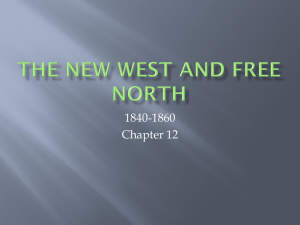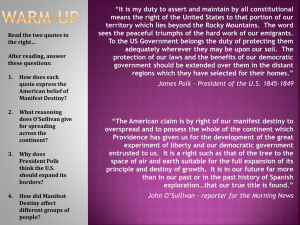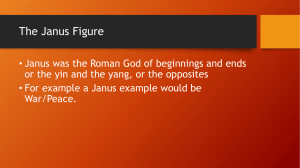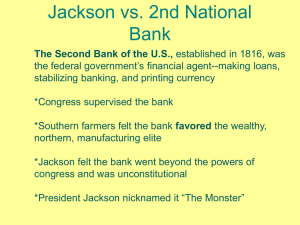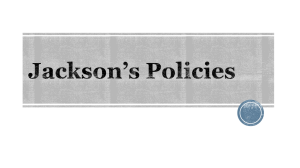AP Manifest Destiny_Jackson bank
advertisement
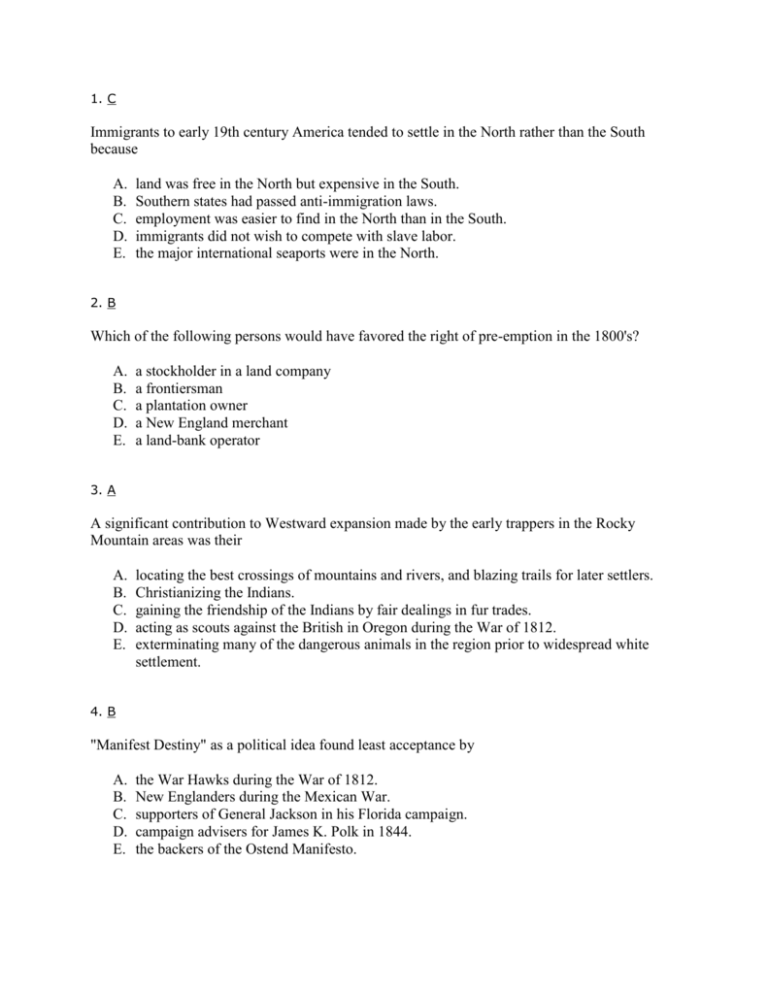
1. C Immigrants to early 19th century America tended to settle in the North rather than the South because A. B. C. D. E. land was free in the North but expensive in the South. Southern states had passed anti-immigration laws. employment was easier to find in the North than in the South. immigrants did not wish to compete with slave labor. the major international seaports were in the North. 2. B Which of the following persons would have favored the right of pre-emption in the 1800's? A. B. C. D. E. a stockholder in a land company a frontiersman a plantation owner a New England merchant a land-bank operator 3. A A significant contribution to Westward expansion made by the early trappers in the Rocky Mountain areas was their A. B. C. D. E. locating the best crossings of mountains and rivers, and blazing trails for later settlers. Christianizing the Indians. gaining the friendship of the Indians by fair dealings in fur trades. acting as scouts against the British in Oregon during the War of 1812. exterminating many of the dangerous animals in the region prior to widespread white settlement. 4. B "Manifest Destiny" as a political idea found least acceptance by A. B. C. D. E. the War Hawks during the War of 1812. New Englanders during the Mexican War. supporters of General Jackson in his Florida campaign. campaign advisers for James K. Polk in 1844. the backers of the Ostend Manifesto. 5. E Which would not have the approval of an American expansionist during the period 1830-1860? A. B. C. D. E. the Slidell mission in Mexico the Ostend Manifesto Jackson's Indian policy the campaign slogan of the Whigs in 1844 Van Buren's policy on Texas 6. B Which statement best describes the status of American literature in the first half of the 19th century? A. The writing of American political theorists of the late 18th century were just gaining recognition abroad. B. Emerson, Thoreau, Hawthorne, and Melville did not yet enjoy the international fame they would one day have. C. Printers were eagerly seeking the writings of American authors to replace the older British writers D. The Hartford Wits had assured America enduring literary fame. E. A grudging respect was being given American writers by European readers. 7. D Henry Clay was an ardent nationalist and expansionist in 1812, but in 1844 he was lukewarm at best on the issue of Texas annexation. What accounts for this change? A. B. C. D. E. He realized that his earlier nationalism had been too extreme. He had become a strong proponent of a liberal land policy. It was more popular to be anti-British than anti-Mexican. The growth of sectionalist passion had made him reluctant to alienate any one section. He was convinced that the annexation of Texas would provoke a war. 8. B John C. Calhoun defended the doctrine of nullification because it A. B. C. D. was a principle stated in the Declaration of Independence. was a constitutional approach to the problem of a state seeking redress. it had been upheld by a Supreme Court decision. it was an extension of the doctrine of implied powers. E. it was central to the philosophy of the land-owning class of the South. 9. D Which of the following can be seen as a deterrent to the growth of nationalism in the United States? A. B. C. D. E. the mobility of the population the influx of immigrants in the 19th century the 10th Amendment the compact theory of government American literature 10. C The popular title, "Our Intellectual Declaration of Independence," was applied to A. B. C. D. E. Thoreau's Civil Disobedience Cooper's Leatherstocking Tales Emerson's The American Scholar Melville's Moby Dick Hawthorne's The House of the Seven Gables 11. C Henry Clay played an important part in arranging a compromise settle for the A. B. C. D. E. Maine boundary dispute. 1828 tariff bill. absorption of the Texas and the Mexican Cession lands. rechartering of the Second Bank of the United States. Oregon settlement with Britain. 12. D Which leader antagonized his own section by his stand on the issue with which he is paired? A. B. C. D. E. James K. Polk - the Mexican War Andrew Jackson - the recharter of the Second Bank of the United States. John Quincy Adams - the Treaty of Ghent. Daniel Webster - the Compromise of 1850. John C. Calhoun - the Tariff of 1828. 13. B "The infant industries of this country must be protected from foreign competition by a protective tariff, and must be further strengthened by a bold program of internal improvements such as the construction of canals and roads." These words were spoken by A. B. C. D. E. William Lloyd Garrison Henry Clay John C. Calhoun Stephen A. Douglas Judah Benjamin 14. E Which of the following documents was nearest in its idea to the principle of the liberum veto practiced in 18th century Poland? A. B. C. D. E. The Declaration of Independence. The Albany Plan of Union. The Monroe Doctrine. The Bill of Rights. The South Carolina Exposition and Protest. 15. C Though he was a self-professed follower of Thomas Jefferson, the development of government under Andrew Jackson represented a trend away from the Jeffersonian ideal in its A. B. C. D. E. attitude toward the Bank. feelings about the worth of the common man. an emphasis upon the supremacy of the Federal Government. sympathy for agrarian problems. dislike of aristocratic custom. 16. D During the Jacksonian Era, the foremost demand of workingmen's organizations was for A. secret balloting. B. minimum wage laws. C. the abolition of slavery. D. a tax-supported public school system. E. outlawing the use of the injunction in industrial disputes. 17. E Which group did not include supporters of the new Whig Party in the 1830's? A. B. C. D. E. National Republicans. advocates of nullification. northern industrialists. people with a personal dislike of Andrew Jackson. advocates of a system of state banks. 18. D "The free grant of land to actual settlers, in consideration of the expenses they incur in making settlements in the wilderness, is a wise and just measure of public policy." Which presidential candidate in the 1848 election made this statement? A. B. C. D. E. Zachary Taylor James G. Birney John C. Fremont Martin Van Buren Lewis Cass 19. A A characteristic common to both major political parties in the 1840's was their A. B. C. D. E. inclusion of conflicting class and regional interests. concentration on national issues and elections. use of the legislative caucus to nominate their presidential candidates. restriction of the spoils system to high salaried positions. advocacy of "manifest destiny" in their platforms. 20. B The right of workers legally to combine into unions to promote their economic interests was established by the A. application of English common law to cases involving unions in American courts. B. decision of Massachusetts Chief Justice Lemuel Shaw in the case of the Commonwealth v. Hunt in 1842. C. decision of the U.S. Supreme Court in the Danbury Hatters case. D. actions of the Workingmen's Party, organized in Philadelphia in 1825. E. labor provisions of the Clayton Anti-Trust Act. 21. E Which reform was achieved in many states during the Jacksonian Era? A. B. C. D. E. granting of equal property rights for women enactment of compulsory school-attendance laws disestablishment of state-supported churches legislation mandating factory inspection abolition of imprisonment for debt 22. B Which of the following contributed to the decline in the 1830's of the anti-slavery movement in the South? A. B. C. D. E. the Missouri Compromise of 1820 resentment of the radical sectionalist propaganda of Northern abolitionists the threat posed by the Liberty Party to Southern plans for gradual emancipation successful Northern obstruction of the annexation of Texas a diminishing number of slave owners of the Jefferson school of thought 23. E Which of the following statements about the Mexican War is least accepted as true by historians? A. Taylor moved into the disputed territory under direct orders from President Polk. B. The Mexican press was confident that the Mexican Army would win a war against the United States. C. The Mexican government planned a war of aggression with the intent of regaining Texas. D. The Mexican government refused to deal with Slidell, the American envoy. E. The war between Mexico and the United States was unavoidable. 24. E Mexico's most justified grievance against the United States over Texas concerned A. B. C. D. E. attempts of Southern slave owners to add slave territory to the United States. constant attempts by United States government to annex Texas. the refusal of the United States to allow settlers to move into Texas. the determination of the United States to obtain Texas without compensating Mexico. United States support of the Texan Revolution. 25. C Opposition to the Treaty of Guadaloupe-Hidalgo came from Senators who A. B. C. D. E. demanded heavy reparations from Mexico. wanted to settle for a clear title to the territory between the Nueces and the Rio Grande. wanted to annex all of Mexico. wanted a guarantee that the territory acquired would be open to slavery. opposed the acquisition of any territory inhabited by Spanish-speaking people. 26. C The view of Andrew Jackson given least credence by modern historians is that he A. B. C. D. E. 27. C strengthened the office of the Presidency. can be seen as the founder of a new political party. was unfit for office because of his rashness, rudeness, and vindictiveness. encouraged both labor and the new business interests. would have won the election of 1824 had the race been between two candidates instead of four. War was ostensibly precipitated over the issue of whether the Nueces River or the Rio Grande was the border of the territory labeled A. B. C. D. E. 28. D A B C D E "It was fortunate for the U.S. that (this territory) was acquired by us in the Treaty of GuadaloupeHidalgo in 1848, because gold was discovered here in 1849." The territory referred to in this quote is a part of the territory on the map labeled A. B. C. D. E. 29. C J E H D C Senator James Gadsden of South Carolina and Secretary of War Jefferson Davis were the prime movers in the purchase of the territory labeled A. B. C. D. E. 30. E G H J F E "This territory was administered jointly by the U.S. and Great Britain from 1815 to 1846, when President Polk decided to accept the offer of a division along the 49th parallel, rather than run the risk of fighting Britain and Mexico at the same time." The territory referred to in this quotation is labeled A. B. C. D. E. 31. D A B C D E War was averted when President Tyler and Secretary of State Webster agreed with British envoy Lord Ashburton that the boundary descriptions of 1783 were useless, and needed to be renegotiated. The consequent Webster-Ashburton Treaty secured for the United States the territory labeled A. B. C. D. E. 32. A H J F G E "Trade between the U.S. and this nation was facilitated by the clipper ships of the first half of the 19th century." The nation referred to in this statement is labeled A. B. C. D. E. 33. E A B C D E The data provided by the graph for the years 1835 to 1840 may reflect A. B. C. D. E. 34. C the effect of the end of the Bank of the United States. the impact of European revolutions upon U.S. trade. the failure of the Democrats to implement the Independent Treasury System. the bankruptcy of several major Southern planters. the economic dislocation which began in 1837. The confrontation between John Bull (Britain) and Brother Jonathan (called Yankee Noodle) is referring to the problem of A. B. C. D. E. 35. B the Alabama Claims. the Ostend Manifesto. the Oregon Boundary Dispute. British recognition of the Confederacy. British fortification of the Canadian border. In this British cartoon published during the controversy over the Oregon Territory, the British attitude toward the United States was one of A. B. C. D. E. angry resentment. amused contempt. apprehensive caution. familial affection. bellicose animosity. 36. A A major confrontation between the executive and legislative branches of government centered on a piece of legislation concerning the American Indians called the A. B. C. D. E. Indian removal Act of 1830. Treaty of Laramie of 1868. Dawes general Allotment Act of 1887. Snyder Indian Citizenship Act of 1924. Wheeler-Howard Indian Reorganization Act of 1934. 37. E Which of the following was precipitated by President Jackson's issuing of the Specie Circular? A. B. C. D. E. A reduction in the tariff rate The chartering of the Second Bank of the United States A renewed interest in the spoils system The eviction of the Cherokee from Georgia The Panic of 1837 38. D A result of Andrew Jackson's actions in the nullification controversy was A. B. C. D. E. the arousal of northern antagonism. the beginning of the Panic of 1837. the election of Calhoun to the Vice-Presidency in 1836. the strengthening of the power of the national government. the settlement of the nullification issue once and for all. 39. D "The people backed him, but the men of property, such as bankers, manufacturers, merchants, disliked him." This statement best applies to A. B. C. D. E. James Monroe. John Quincy Adams. Henry Clay. Andrew Jackson. Martin Van Buren. 40. E According to the South Carolina Exposition and Protest, a federal law could be nullified by a state government because the Federal government was A. B. C. D. E. dependent upon the states for revenue. composed of men appointed from or elected by the states. limited in its powers by the Bill of Rights. uncontrollable by any other means. created by the states, and thus not superior to them. 41. B The outstanding issue in the United States in the period from 1840 to 1850 was A. B. C. D. E. the expansion of the meaning of the Monroe Doctrine. territorial expansion. development of the China trade. reform of the banking system. slavery. 42. A Which issue aroused the strongest sectional feeling during the presidency of Andrew Jackson? A. B. C. D. E. the tariff the spoils system the new nomination process relocation of the Cherokee "Eaton malaria" 43. D Which of the following was an important factor in the movement for a tax-supported public school system in the United States during the Jacksonian Era? A. B. C. D. E. 44. D suspicion of parochial schools the heritage of state-supported school brought from Europe by immigrants the leadership of wealthy intellectuals who believed in social equality the growth of a wage-earning urban class who wanted a better future for its children a fear that other nations might begin to gain an upper hand in technology The person who drew this cartoon was probably a A. B. C. D. E. 45. C Democrat. Federalist. Republican. Whig. Free-Soiler. The sentiments expressed in this cartoon represent the view of people who voted for A. B. C. D. E. 46. E Martin Van Buren in 1840. James Monroe in 1820. Henry Clay in 1832. John Quincy Adams in 1836. William Crawford in 1824. The primary inspiration for this cartoon was probably the fact that A. Jackson pointedly ignored the court order issued by Chief Justice Marshall relative to the Indian Removal Act. B. subverted the Second Bank of the United States by removing federal deposits. C. refused even to consider the nullification concept put forth by Calhoun. D. took the side of Peggy Eaton against the snobbish high E. used the veto power more than all the previous presidents combined. 3240025 True 0 0 1
